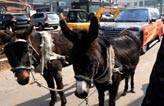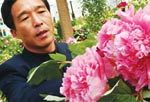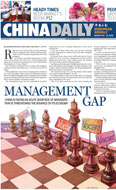Asia
Tainted seafood fears spread as plant leaks
Updated: 2011-03-31 07:13
(Agencies)
TOKYO - Fears about contaminated seafood spread Wednesday despite reassurances that radiation in the waters off Japan's troubled atomic plant pose no health risk, as the country's respected emperor consoled evacuees from the tsunami and nuclear emergency zone.
While experts say radioactive particles are unlikely to build up significantly in fish, the seafood concerns in the country that gave the world sushi are yet another blemish for Brand Japan. It has already been hit by contamination of milk, vegetables and water, plus shortages of auto and tech parts after a massive quake and tsunami disabled a coastal nuclear power plant.
Spokesman Naoki Tsunoda said Shimizu, 66, was admitted to a Tokyo hospital Tuesday after suffering dizziness and high blood pressure.
The problems at the nuclear plant have taken center stage, but the tsunami also created another disaster: Hundreds of thousands of people were forced from their homes after the wave drove miles (kilometers) inland, decimating whole towns. The official death toll stood at 11,362 late Wednesday, with the final toll likely surpassing 18,000.
Japan's respected Emperor Akihito and Empress Michiko visited disaster evacuees at a center in Tokyo on Wednesday. The visit was marked by a formality that is typical of interactions with the royal couple, but survivors said they were encouraged.
"I couldn't talk with them very well because I was nervous, but I felt that they were really concerned about us," said Kenji Ukito, an evacuee from a region near the plant who has already moved four times since the quake. "I was very grateful."
The emperor and his wife make fairly frequent public appearances, visiting nursing homes and the disabled and attending ceremonies throughout the year. In particular, they are expected to mourn with those affected by natural disasters. Akihito made a similar visit to evacuees after the Kobe earthquake in 1995.
At the Fukushima plant, the fight to cool the reactors and stem their release of radiation has become more complicated in recent days since the discovery that radioactive water is pooling in the plant, restricting the areas in which crews can work. It also puts emergency crews in the uncomfortable position of having to pump in more water to continue cooling the reactor while simultaneously pumping out contaminated water.
That contamination has also begun to seep into the sea, and tests Wednesday showed that waters 300 yards (meters) outside the plant contained 3,355 times the legal limit for the amount of radioactive iodine.
It's the highest rate yet, but Nuclear and Industrial Safety Agency official Hidehiko Nishiyama said it did not pose any threat to human health because the iodine rarely stays in fish. There is no fishing in the area because it is within the evacuation zone around the plant.
Radioactive iodine is short-lived, with a half-life of just eight days, and in any case was expected to dissipate quickly in the vast Pacific Ocean. It does not tend to accumulate in shellfish.
Other radioactive particles have been detected in the waters near the plant, and some have made their way into fish. Trace amounts of radioactive cesium-137 have been found in anchovies as far afield as Chiba, near Tokyo, but at less than 1 percent of acceptable levels.
"We have repeatedly told consumers that it is perfectly safe to eat fish," said Shoichi Takayama, an official with Japan's fishery agency.
Citing dilution in the ocean, the US Food and Drug Administration has played down the risks of seafood contamination.
But, as with other reports of radiation levels in food and tap water, fear has begun to override science. Several countries, including India and South Korea, have ordered special inspections for or outright bans on fish from areas near the plant.
Ren Cheng, a spokesman for Taiwan's Mitsui Food & Beverage Enterprise Group that operates several upscale Japanese restaurants in Taipei, said his company has seen a 50 percent drop in revenue since the crisis began.
"We are not importing any food products from Japan. All the Japanese ingredients we are using were all procured before the quake," he said. "We have put up signs in our restaurants to reassure costumers about the safety of our food."
Domestic consumption, however, is far more important to Japan, which imports far more seafood than it exports. According to the fisheries agency, the domestic catch typically totals around 5.5 million tons. Less than a million of that gets exported, while another nearly 3 million tons are imported.
In stores near Tokyo's famed Tsukiji fish market, fresh fish was selling poorly.
Instead, customers "are stockpiling" frozen fish, in the hopes it was caught before radiation began to climb, said Hideo Otsubo, who works at a seafood company near the market.
Tourism to Japan has fallen sharply since the disaster, and sushi chef Akira Ogimoto blamed that dropoff for a 30 to 40 percent decline in customers to his restaurant near the market, where the daily tuna auction is a big draw for foreigners.
Add on the radiation fears, and fishermen are worried their livelihoods will be threatened just when they need to rebuild their homes.
"I worry we won't be able to sell our seaweed. If the radiation ruins our fishing, we are lost," said Toshiaki Kikuchi, a 63-year-old innkeeper and seaweed farmer in Soma, a city near the troubled plant.
The International Atomic Energy Agency, meanwhile, reported Wednesday it found radiation in a village outside the evacuation zone at levels that are twice where it would recommend evacuations. Officials emphasized the reading was found in only one spot in Iitate village, about 25 miles (40 kilometers) from the plant, and did not say they were recommending an evacuation. The exclusion zone has a radius of 12 miles (20 kilometers).
E-paper

Rise and shine
The Chinese solar energy industry is heating up following recent setbacks in the nuclear sector
Preview of the coming issue
Bombs aim for regime change
CSI, with a twist
Specials

Donkey-powered Land Rover
Two donkeys pull a broken-down Land Rover in Shenyang, Liaoning province.

China Fashion Week
Models present creations for the Hosa Swimwear Trend Press Conference 2011.

Peony express
Growers of china's unofficial national flower are reaching out to europe for help




